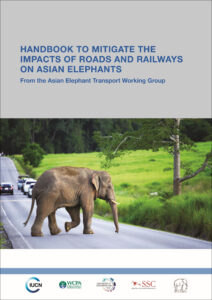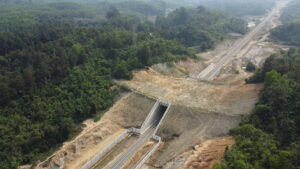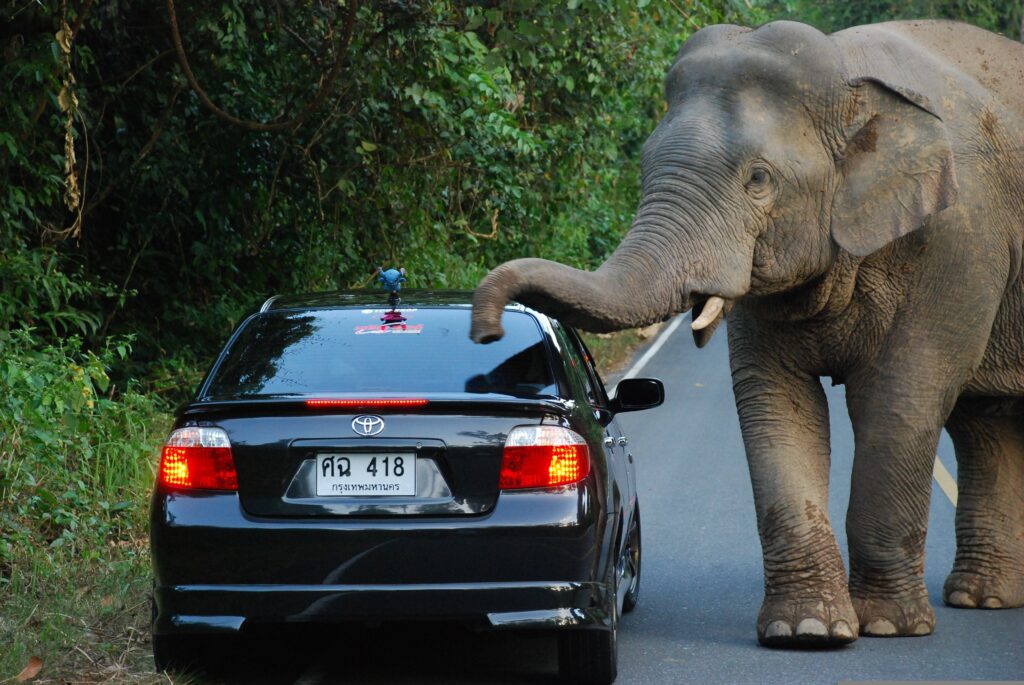International Experts Publish Handbook on Creating Elephant-friendly Linear Infrastructure
NEWS RELEASE
March 18, 2024

BOZEMAN, MT ─ A century ago, an estimated 100,000 elephants roamed throughout Asia. Today, fewer than half that number of Asian elephants remain in just 13 countries. Among the reasons for this decline is the explosion of new roads, railways and other linear infrastructure across the continent. In fact, collisions with cars and trains are a leading cause of elephant mortality in India, and many more elephants are impacted by roads and railways causing habitat loss and fragmentation.
In response, The Center for Large Landscape Conservation (CLLC) and its partners in the Asian Elephant Transport Working Group (AsETWG) announce the publication of the first elephant-specific handbook to help countries reduce collisions and provide safe passage for elephants. The Handbook to Mitigate the Impacts of Roads and Railways on Asian Elephants was co-authored by two CLLC staff members alongside nine other experts on elephants and transport ecology from the AsETWG—a joint collaboration of the IUCN WCPA Connectivity Conservation Specialist Group and the IUCN SSC Asian Elephant Specialist Group comprised of more than 30 volunteer experts. It aims to provide workable solutions for transportation planners and engineers to protect Asian elephants from the negative impacts of roads and railways.
“Elephants need to move to survive—to find food, water, and mates. In some cases, new roads and railways are being built right across ancient Asian elephant migration routes,“ says CLLC Senior Conservationist Rob Ament, who is Co-chair of the AsETWG and co-author of the Handbook.
Ament says such impacts will grow in the future, given the rapid pace of LI development in Asia, so avoiding and mitigating the impacts of roads and railways is essential for conserving this endangered species.
“This Handbook gives specific recommendations for reducing the harmful impacts of roads and railways by providing expert-informed guidance on designing larger, elephant-specific crossings,” says Ament.

“This publication combines decades of experience from the contributors and is a prime example of collaboration across sectors and political boundaries to tackle a serious conservation issue,” adds CLLC International Connectivity Project Specialist Melissa Butynski, who is Coordinator of the AsETWG and co-author of the Handbook.
“People living and working in countries with Asian elephants see the very real threats from linear infrastructure this incredible species faces,” says Butynski. “There is a sense of urgency to act before it’s too late.”
Today, Asian elephants are listed as ‘Endangered’ on the IUCN Red List of Threatened Species, and only an estimated 52,000 elephants remain in populations increasingly isolated from one another in Bangladesh, Bhutan, Cambodia, China, India, Indonesia, Laos, Malaysia, Myanmar, Nepal, Sri Lanka, Thailand and Vietnam.
The authors plan to introduce the Handbook’s recommendations within these countries and help facilitate next steps for solutions via webinars and in-person workshops for engineers, transportation planners, policymakers, financiers, government officials, conservationists and researchers.
Vivek Menon, Co-founder of Wildlife Trust of India, Chair of the IUCN SSC Asian Elephant Specialist Group and author of the Handbook’s foreword, wrote, “I hope these guidelines find wide usage across the elephant range and that it is adapted and translated into local languages, so that its use across all 13 countries that still have the Asian elephant is encouraged.”
The Handbook to Mitigate the Impacts of Roads and Railways on Asian Elephants was made possible through the support of the International Connectivity Program at the Center for Large Landscape Conservation, World Wildlife Fund, Whitley Fund for Nature and Friends. It was also supported in part by the Asia’s Linear Infrastructure safeGuarding Nature (ALIGN) Project, which aims to enhance the development and implementation of effective, high-quality linear infrastructure safeguards that protect people and nature from harm. The ALIGN Project is made possible by the generous support of the American people through the United States Agency for International Development (USAID).
About the Asian Elephant Transport Working Group
The Asian Elephant Transport Working Group serves as the hub of expertise, synthesis, integration, practical guidance, and technical support to deliver practical, flexible, and science-based solutions that avoid and mitigate threats to Asian elephants posed by linear transportation infrastructure across all 13 range states. It is a joint collaboration of the IUCN WCPA Connectivity Conservation Specialist Group and the IUCN SSC Asian Elephant Specialist Group (AsESG). conservationcorridor.org/ccsg/working-groups/asetwg
About the Center for Large Landscape Conservation
The Montana, USA-based Center for Large Landscape Conservation advances ecological connectivity for climate resilience worldwide through science, policy, practice, and collaboration. The Center coordinates the Asian Elephant Transport Working Group as part of their role as Secretariat of the IUCN WCPA Connectivity Conservation Specialist Group (CCSG) largelandscapes.org
###
CONTACT:
Christine Weinheimer
Communications Manager
Center for Large Landscape Conservation
communications@largelandscapes.org
Top photo: Asian elephant with automobile. Credit: stbaumgaertner via Pixabay



